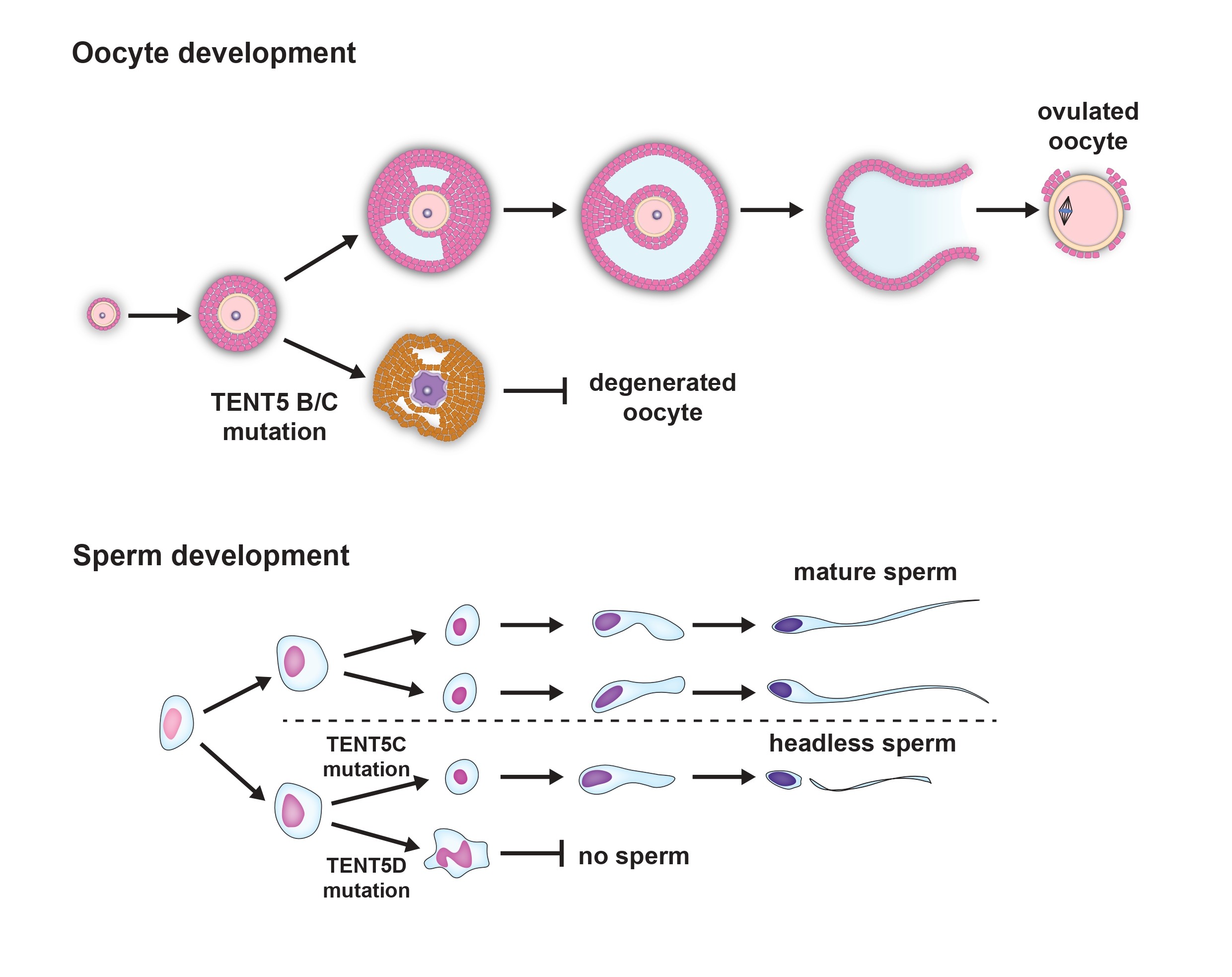Scientists from IIMCB have discovered the molecular basis of infertility
Every year, millions of couples around the world struggle with infertility. According to the WHO, the problem affects as much as one-sixth of the global population. Research conducted by scientists from IIMCB, published in Nature Communications and Scientific Data, provides better insight into the molecular basis of abnormal development of egg and sperm cells.
Science continues to search for answers about the molecular mechanisms leading to infertility. A team of researchers from the Laboratory of RNA Biology - ERA Chairs Group at the International Institute of Molecular and Cell Biology (IIMCB) focused on TENT5 proteins, which have only recently attracted the attention of biologists. These proteins were identified through bioinformatic analyses only in 2016. They are responsible for polyadenylation – a process essential, among other things, for the proper development of egg and sperm cells.
 Fig.: Diagram of the development of the mouse egg cell and sperm.
Fig.: Diagram of the development of the mouse egg cell and sperm.
It highlights how mutations in various Tent5 family genes lead to developmental disorders of those cells, indicating their function. Tent5b and Tent5c together are essential for the development of the egg cell.
Tent5c additionally regulates the final stage of sperm development, while Tent5d is crucial for the early stages.
A discovery reaching beyond laboratories
"Put simply, without TENT5 proteins there is no polyadenylation, and without polyadenylation there is no life," says one of the main authors of the study, Dr. Michał Brouze. "Until now, it was believed that if TENT5 proteins were absent or did not function properly for various reasons, they could be replaced by other proteins. We have demonstrated that they are irreplaceable – this represents a significant change in the current understanding of the molecular mechanisms of fertility and infertility," adds the IIMCB researcher.
The study combined various methodologies and aspects of biological research. The team studied mutations of four TENT5 family proteins in mice using classical embryology methods. They focused on the morphology of oocytes and sperm and their potential for development and fertilization. At the same time, they applied the most advanced and precise techniques for studying nucleic acids, including full-length RNA sequencing using nanopores on the ONT platform and the search for repetitive motifs in these sequences that could determine the specificity of TENT5 protein activity. A comprehensive analysis of the data thus obtained by MSc Agnieszka Czarnocka-Cieciura, the lead author of the paper published in Scientific Data, enabled the identification of specific TENT5-dependent genes essential for gamete development.
"Our study, described in the recent publications, reveals specific molecular mechanisms and directly increases understanding of the function of key processes in egg and sperm cells," says Dr. Michał Brouze. "These findings will be valuable to researchers investigating cytoplasmic polyadenylation in the context of gametogenesis and infertility. As a result, our findings may go beyond laboratories and form a foundation for future infertility treatments," concludes the molecular biologist.
Groundbreaking research in the history of IIMCB
It is worth noting that the article published in Nature Communications describing the role of TENT5 proteins won first place in the Institute's internal competition for the best scientific publication – Best Papers Awards 2024. "Obtaining such significant results would not have been possible without the infrastructural support of IIMCB through the Molecular and Cell Research Infrastructure IN-MOL-CELL – I would especially like to thank the Genome Engineering Unit led by Dr. Olga Gewartowska, which was responsible for creating the genetically modified mouse lines used in this study," emphasizes Dr. Michał Brouze.
The scientific articles published in Nature Communications and Scientific Data also served as the basis for the doctoral dissertation of Dr. Michał Brouze, written under the supervision of Prof. Andrzej Dziembowski, titled “Analysis of the Role of Selected Exoribonucleases and Poly(A) Polymerases in Mus musculus”. The defense of this work, held on February 21, 2025, was the first in the Institute's history. Thus, the International Institute of Molecular and Cell Biology inaugurated a new chapter in its history by enabling the completion of a full doctoral path – from research to defense – under one roof of a leading Polish research institution with international recognition.
The article in Nature Communications titled “TENT5-mediated polyadenylation of mRNAs encoding secreted proteins is essential for gametogenesis in mice” is available here: https://www.nature.com/articles/s41467-024-49479-4
The article in Scientific Data titled “Comprehensive analysis of poly(A) tails in mouse testes and ovaries using Nanopore Direct RNA Sequencing” is available here: https://www.nature.com/articles/s41597-024-04226-8
